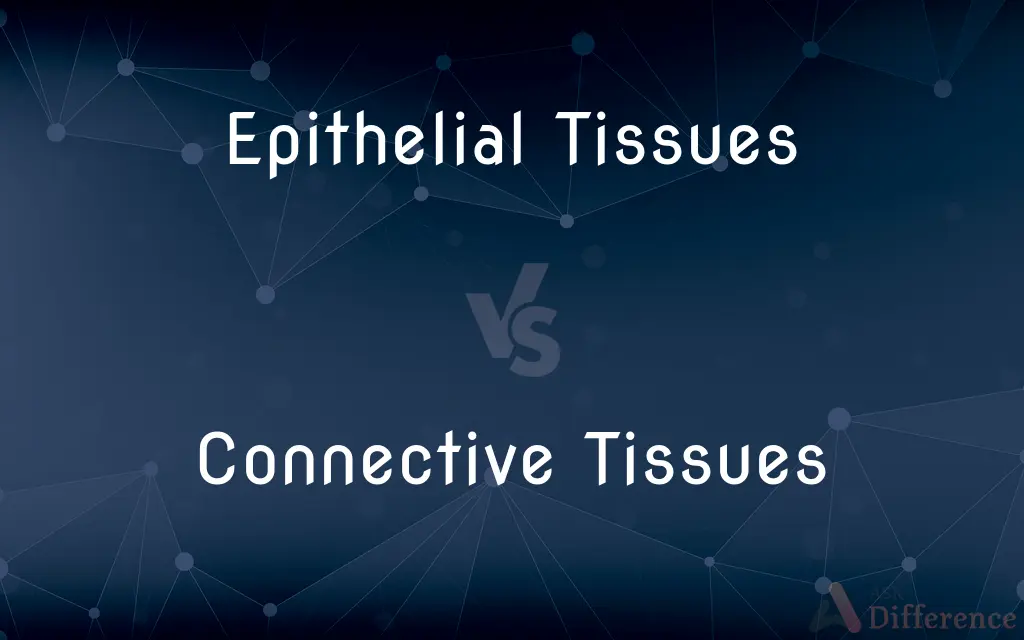Epithelial Tissues vs. Connective Tissues — What's the Difference?
Edited by Tayyaba Rehman — By Fiza Rafique — Published on January 13, 2024
Epithelial tissues form protective layers and are involved in absorption and secretion, while connective tissues support, bind, or separate other tissues and organs.

Difference Between Epithelial Tissues and Connective Tissues
Table of Contents
ADVERTISEMENT
Key Differences
Epithelial tissues line the cavities and surfaces of structures throughout the body, and they also form many glands. Unlike epithelial tissues, connective tissues support and anchor organs, store energy as fat, and provide immunity with different cells like fibroblasts and macrophages.
While epithelial tissues have cells that are closely packed with minimal extracellular matrix, connective tissues are characterized by having few cells scattered within an abundant extracellular matrix. This matrix often includes fibers like collagen and can be quite dense, as seen in tendons, or loose, as in adipose tissue.
Epithelial tissues are avascular, meaning they do not contain blood vessels and are nourished by diffusion from underlying tissues. Connective tissues are typically vascularized, with the exception of cartilage, and thus have a direct supply of nutrients through blood vessels.
Epithelial tissues can regenerate quickly following injury due to the presence of stem cells. Connective tissues have varying capacities for regeneration; for example, bone heals well, whereas cartilage does not.
In epithelial tissues, the cells exhibit polarity with an apical surface that faces the outside of the body or an internal space, and a basal surface that is attached to a basement membrane. Connective tissues do not display polarity but are embedded in a matrix that can withstand forces of tension and compression, providing structural and functional support.
ADVERTISEMENT
Comparison Chart
Primary Function
Covering and lining surfaces; glandular functions
Supporting, binding, and protecting other tissues
Cellularity
High cell density with little extracellular space
Sparsely distributed cells in abundant matrix
Blood Supply
Avascular (no blood vessels)
Mostly vascularized (has blood vessels)
Regenerative Ability
High regenerative capacity
Variable regenerative capacity
Polarity
Cells exhibit polarity
Cells do not exhibit polarity
Extracellular Matrix
Minimal
Abundant with fibers like collagen
Location
Surfaces such as skin, lining of organs
Throughout the body in bones, blood, fat, etc.
Cell Shapes
Squamous, cuboidal, columnar
Fibroblasts, macrophages, adipocytes, etc.
Attachment
Attached to a basement membrane
Not typically attached to a membrane
Examples
Skin epithelium, intestinal lining
Bone, cartilage, adipose, blood
Compare with Definitions
Epithelial Tissues
Epithelial tissues serve as a barrier to protect underlying structures.
The epithelial tissue in the mouth prevents the invasion of pathogens.
Connective Tissues
Connective tissues can have various levels of vascularity, from avascular cartilage to highly vascularized blood tissue.
Cartilage connective tissue cushions joints despite its lack of blood supply.
Epithelial Tissues
Epithelial tissues form continuous sheets that cover or line body surfaces.
The skin is composed of stratified squamous epithelial tissue.
Connective Tissues
Connective tissues include bone, cartilage, blood, and lymph.
Bone's connective tissue provides structural support for the body.
Epithelial Tissues
Epithelial tissues are involved in absorption, secretion, and sensation.
The intestinal lining's epithelial tissue is essential for nutrient absorption.
Connective Tissues
Connective tissues support and bind other tissues of the body.
Connective tissue in the form of tendons connects muscles to bones.
Epithelial Tissues
Epithelial tissues are characterized by closely-packed cells with minimal intercellular substances.
Epithelial tissues in the lungs facilitate the exchange of oxygen and carbon dioxide.
Connective Tissues
Connective tissues contain cells embedded in an extracellular matrix.
Adipose tissue is a type of connective tissue that stores fat.
Epithelial Tissues
Epithelial tissues can be simple or stratified based on the number of layers.
The bladder is lined with transitional epithelial tissue that stretches during filling.
Connective Tissues
Connective tissues are vital for protection, insulation, and transportation of materials.
Blood, a liquid connective tissue, transports oxygen to cells.
Common Curiosities
How do connective tissues differ from epithelial tissues in terms of cellularity?
Connective tissues have fewer cells scattered in a rich extracellular matrix, unlike the densely packed cells of epithelial tissues.
Can connective tissues regenerate?
Yes, but the capacity varies by type; some, like bone, regenerate well, while others, like cartilage, do not.
Are epithelial tissues vascular?
No, epithelial tissues are avascular and get nutrients through diffusion from underlying tissues.
What is the primary function of epithelial tissues?
Epithelial tissues primarily cover body surfaces, line body cavities, and form glands.
How does the regenerative ability of epithelial tissues compare to connective tissues?
Epithelial tissues generally have a higher regenerative ability than connective tissues.
How does the thickness of epithelial tissues vary?
Epithelial tissues can be a single cell layer (simple) or multiple layers thick (stratified).
What types of cells are found in connective tissues?
Cells such as fibroblasts, adipocytes, and macrophages are found in connective tissues.
What is the role of the extracellular matrix in connective tissues?
The extracellular matrix provides structural support and mediates various functions, including tissue repair.
Are all connective tissues highly vascularized?
No, for instance, cartilage is avascular, but most connective tissues have a good blood supply.
Can the epithelial tissue sense stimuli?
Yes, certain epithelial tissues have specialized sensory functions.
Do epithelial tissues have polarity?
Yes, epithelial cells have an apical surface and a basal surface, indicating polarity.
Where is epithelial tissue commonly found?
Epithelial tissue is found on surface layers of the body, such as the skin and the lining of the gastrointestinal tract.
Is it possible to find connective tissue inside blood vessels?
Yes, blood itself is considered a connective tissue.
What is the significance of the basement membrane in epithelial tissues?
The basement membrane anchors the epithelial tissue to underlying connective tissue.
What is the difference in cell shape between epithelial and connective tissues?
Epithelial cells have defined shapes like squamous, cuboidal, or columnar, while connective tissue cells vary more in shape and function.
Share Your Discovery

Previous Comparison
Primavera vs. MS-Project
Next Comparison
Organizational Development vs. Organizational TransformationAuthor Spotlight
Written by
Fiza RafiqueFiza Rafique is a skilled content writer at AskDifference.com, where she meticulously refines and enhances written pieces. Drawing from her vast editorial expertise, Fiza ensures clarity, accuracy, and precision in every article. Passionate about language, she continually seeks to elevate the quality of content for readers worldwide.
Edited by
Tayyaba RehmanTayyaba Rehman is a distinguished writer, currently serving as a primary contributor to askdifference.com. As a researcher in semantics and etymology, Tayyaba's passion for the complexity of languages and their distinctions has found a perfect home on the platform. Tayyaba delves into the intricacies of language, distinguishing between commonly confused words and phrases, thereby providing clarity for readers worldwide.
















































